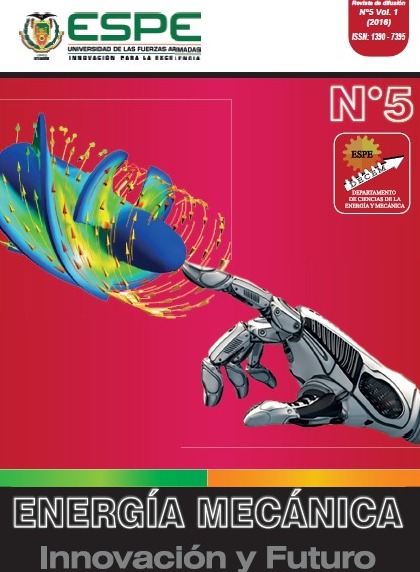SIMULACIÓN DE CONSUMO DE COMBUSTIBLE Y EMISIONES DEVEHÍCULOS DE TRANSPORTE PÚBLICO EN LA CIUDAD DE AMBATO(ECUADOR) MEDIANTE COPERT 4
DOI:
https://doi.org/10.24133/EMIF.V5.6i.3950Abstract
RESUMEN
Se simula el consumo de combustible y
emisiones de una flota de vehículos de
transporte público a partir de información
de circulación bajo configuraciones de
relieve y orografía específica de la ciudad
de Ambato, provincia de Tungurahua,
en la República de Ecuador, mediante la
utilización del Software COPERT 4
Se parte del señalamiento de un caso
modelo inicial, donde se aplica el
cálculo informático para un vehículo en
un recorrido de un kilómetro, posterior
a lo que se procede a la realización del
ajuste de la metodología para aplicarlo al
caso específico de la ciudad de Ambato,
cuya estructura está compuesta por dos
enfoques principales: una configuración
de recorrido plano sin aplicación de la
orografía característica de la urbe, y una
conformación que incluya la orografía
irregular partiendo de porcentajes
de afección dentro del recorrido tipo
que satisfaga los requerimientos
característicos de un circuito general de
transporte público local.
Se concluye el desarrollo con la
presentación de proyecciones de
emisión en escenarios hipotéticos de
actualización o reforma completa de la
flota hacia tecnologías con aplicación
de legislaciones de control con una
mayor eficiencia, pudiendo así apoyar
la toma de decisiones políticas iniciales
por parte de los gobierno locales hacia
la transformación de la matriz de
transporte eficiente y con menor índice
de contaminación medioambiental.
Palabras clave
COPERT, transporte público, consumo de
combustible, emisiones contaminantes.
ABSTRACT
Simulate fuel consumption and
emissions of the fleet of public transport
vehicles from information on specific
configurations of relief and topography
of the city of Ambato, Tungurahua
Province, Republic of Ecuador, by using
the Stwofare COPTE R 4.
The investigation starts from the
assignment of an initial model case
that represents the earliest computer
calculations for only one vehicle at
one kilometer of road. From this initial
procedure, the investigation proceeds
to the methodological adjustment of the
COPERT model to apply in the specific
case of Ambato, which structure is
composed from two main perspectives:
one plain road configuration analysis
without the influence of the typical urban
topography, and another configuration
that includes this irregular relief
obtained from affection percentages
of road inclination, satisfying the
main requirements of the local public
transportation circuit.
In the final chapter the future
hypothetical effects of emissions in
two different scenarios are presented:
the update of one half of the fleet or
the complete change of the entire
fleet to technologies with highest
efficiency control standards, providing
the starting support for initial political
decisions from local governments
towards the transformation of a
superb transportation matrix with less
environment contamination levels.
Keywords
COPERT, Public Transportation, Fuel
Consumption, Pollution Emissions.
[1] D. Gkatzoflias (Emisia S.A.), C. Kouridis
(Emisia S.A.), L. Ntziachristos (LAT/
AUTH), Z. Samaras (LAT/AUTH).
(2012). COPERT IV Users Manual.
Thessaloniki, Grecia: Emisia S.A.
[2] L. Ntziachristos, P. Boulter (2009).
EMEP/CORINAIR Atmospheric
Emissions Inventory Guidebook
chapter on tyre, break and surface
wear. EEA.
[3] L. Ntziachristos, Z. Samaras (2014).
EMEP/CORINAIR Atmospheric
Emissions Inventory Guidebook
chapter on exhaust emissions from
road transport. EEA.
[4] G. Mellios, L. Ntziachristos (2009).
EMEP/CORINAIR Atmospheric
Emissions Inventory Guidebook
chapter on fuel evaporation from
gasoline vehicles. EEA.
[5] Almodóvar, J. A. (2015). Simulación
de emisiones y consumo de
combustible de la flota de Valladolid
con COPERT 4. Valladolid, España:
UVa.
[6] Baumert, K., Herzog, T., &
Pershing, J. (2005). Navigating the
number: Greenhouse Gas Data
and International Climate Policy.
Washington D.C., Estados Unidos:
Instituto de Recursos Mundiales.
[7] Bahamonde, A. (2001). Eliminación
de NOX en gases de combustión,
reducción catalítica selectiva.
Madrid: CSIC.
[8] Cives Vilar, J. (2011). La sonda
lambda como elemento de control
de emisiones. Leganés, España:
Universidad Carlos III de Madrid.
[9] Clean Air Institute. (2013).
Metodologías para la estimación de
emisiones de transporte urbano y de
carga y guías para la recompilación
y organización de datos. Washington
D.C., Estados Unidos: CAI Clean Air
Institute.
[10] González, R. (2005). Los ciclos de
manejo, una herramienta útil si es
dinámica para evaluar el consumo
de combustible y las emisiones
contaminantes del auto transporte.
México Distrito Federal, México:
UNAM MX.
[11]Macías, J., Martínez, H., & Unal,
A. (2010). Bus Technology Meta-
Analysis. Bus Technology Meta-
Analysis. Reunión anual del Consejo
de Investigación sobre el Transporte.
[12] Agencia de protección ambiental
EPA. (23 de Julio de 2012). www.
epa.gov. Consultada en 3 de
Enero de 2015 desde Agencia de
protección ambiental de los Estados
Unidos: http://www.epa.gov/air/
airpollutants.html
[13] Centro de Investigaciones
Energéticas, Medioambientales
y Tecnológicas. (15 de Agosto de
2010). wwww.ciemat.es. Consultada
en 3 de Enero de 2016 from Centro
de Investigaciones Energéticas,
Medioambientales y Tecnológicas:
http://www.ciemat.es/MCAportal/
portal.do;jsessionid
[14] Economiasimple.net. (18 de Agosto
del 2011). Consultada en 21 de
diciembre de 2015 desde Economía
doméstica, factores a tomar en
cuenta para ahorrar combustible
http://www.economiasimple.net/
factores-a-tener-en-cuenta-paraahorrar-
combustible.html
Downloads
Published
Issue
Section
License
Los autores que publican en esta revista están de acuerdo con los siguientes términos:
Los autores conservan los derechos de autor y garantizan a la revista el derecho de ser la primera publicación del trabajo al igual que licenciado bajo una Creative Commons Attribution License que permite a otros compartir el trabajo con un reconocimiento de la autoría del trabajo y la publicación inicial en esta revista.
Los autores pueden establecer por separado acuerdos adicionales para la distribución no exclusiva de la versión de la obra publicada en la revista (por ejemplo, situarlo en un repositorio institucional o publicarlo en un libro), con un reconocimiento de su publicación inicial en esta revista.
Se permite y se anima a los autores a difundir sus trabajos electrónicamente (por ejemplo, en repositorios institucionales o en su propio sitio web) antes y durante el proceso de envío, ya que puede dar lugar a intercambios productivos, así como a una citación más temprana y mayor de los trabajos publicados.

